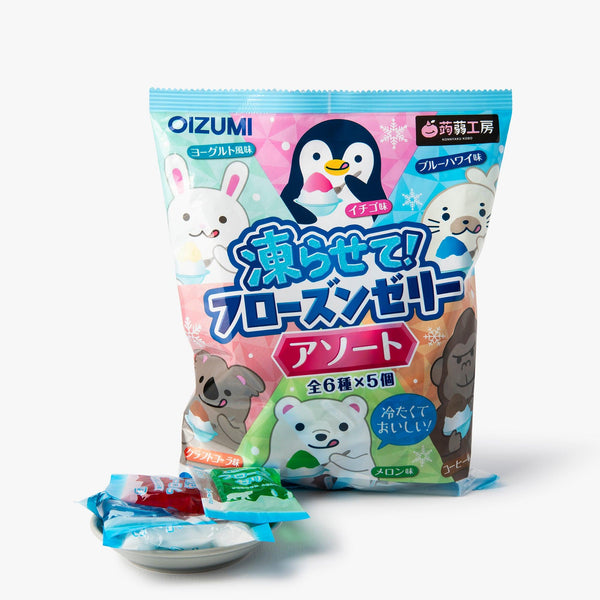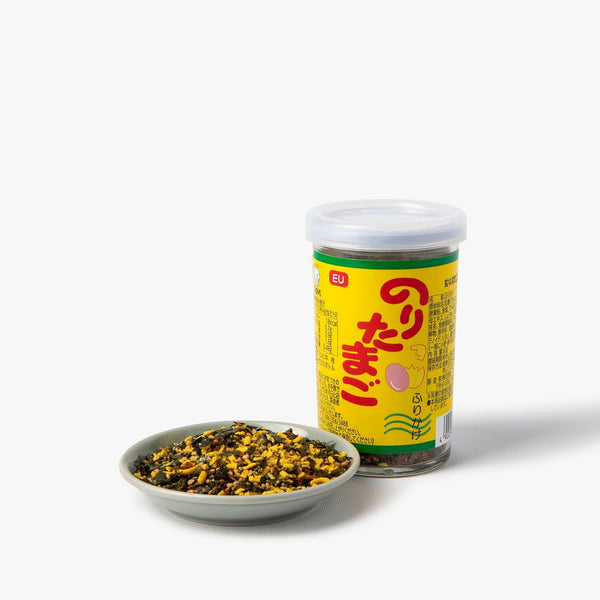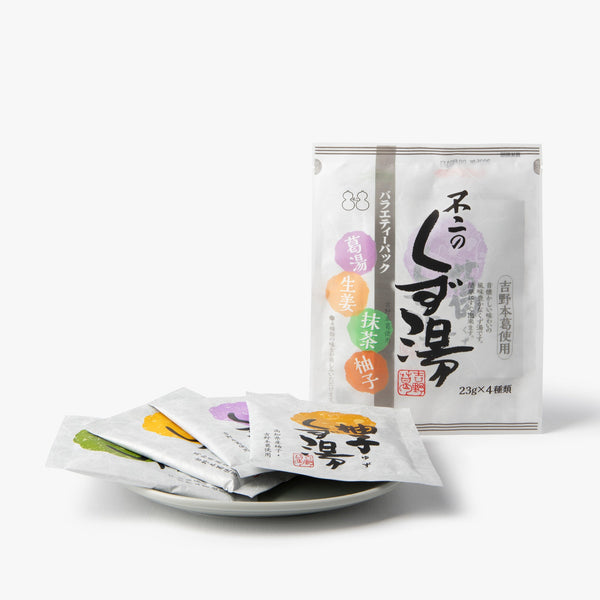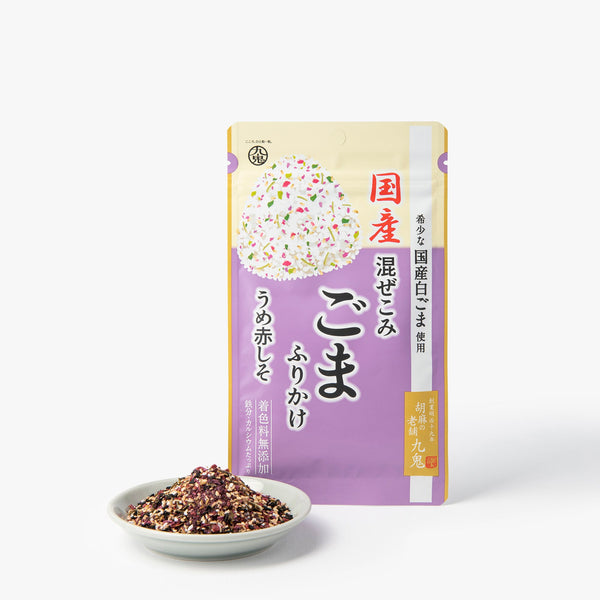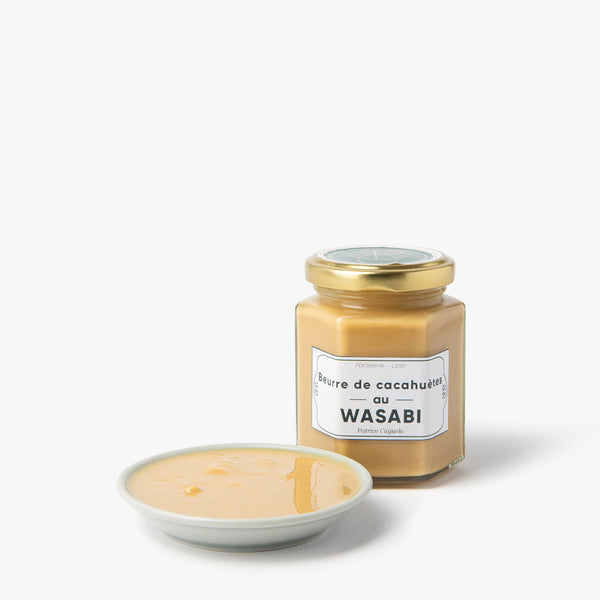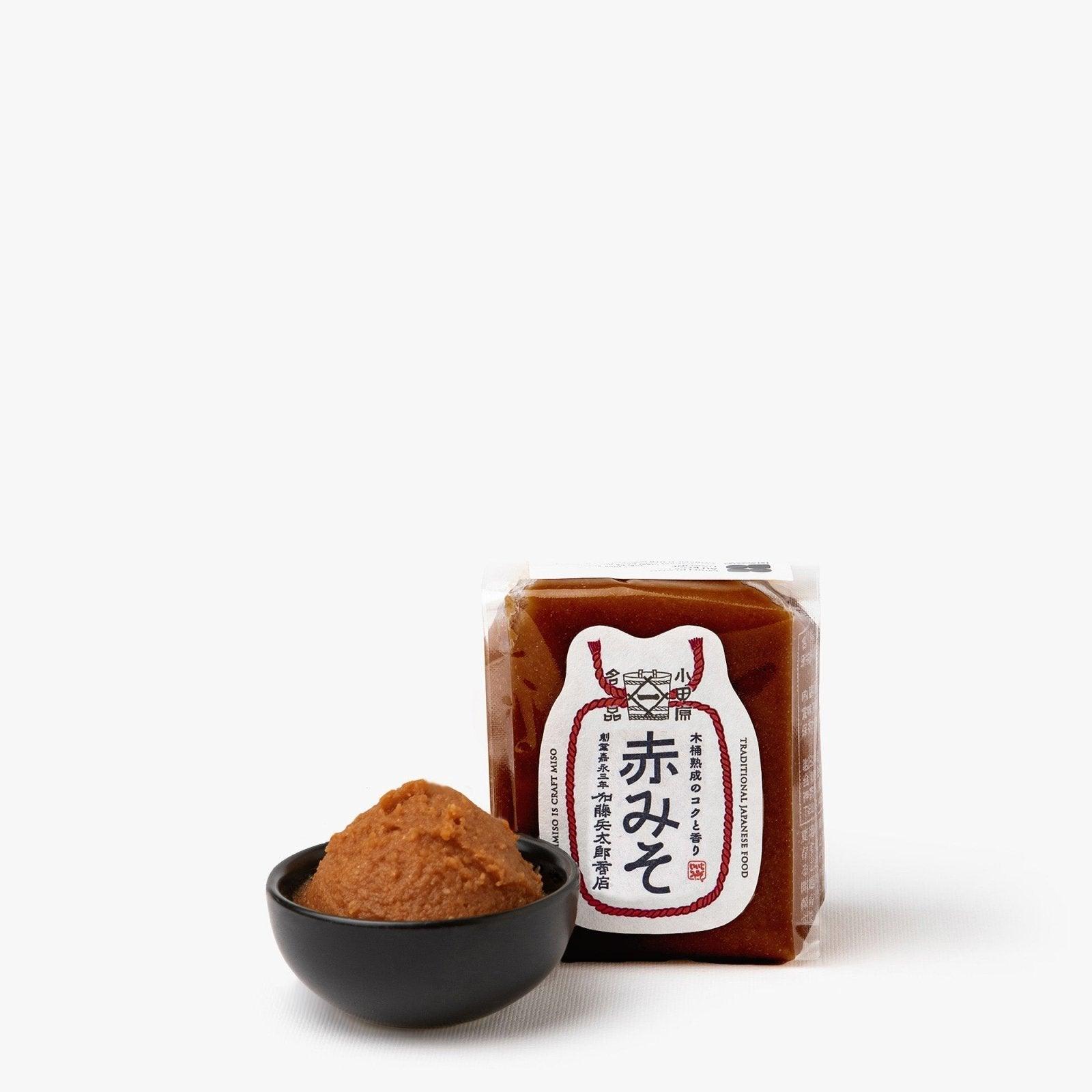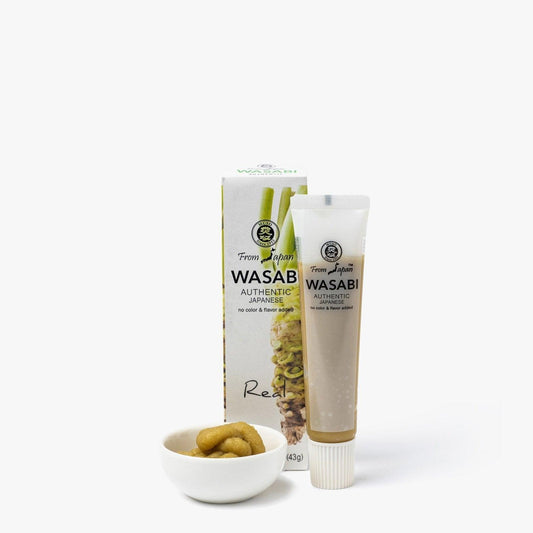A
ABURAAGE 油揚げ: Fried tofu finely cut into rectangular or square slices. It can be stuffed or added to dishes as you wish.
AGAR-AGAR 寒天 (kanten) : a natural gelling agent extracted from red seaweed. Widely used in Japanese and Asian cuisine, it can be used to make jellies, desserts and vegetable preparations. Unlike animal gelatin, it offers a firmer texture and solidifies at room temperature.
AJITSUKE TAMAGO 味付け卵:these are brown hard-boiled eggs that have been marinated in soy sauce, mirin and/or sake and sugar for at least 24 hours to fully exploit all the marinade's flavors. They are mainly found in ramen, but can also make wonderful snacks!
AMAZAKE 甘酒: traditional Japanese drink, slightly sweetened and with little or no alcohol, obtained by fermenting rice. It is made from kōji (Aspergillus oryzae) or sake production residues. Rich in enzymes, B vitamins and amino acids, it is appreciated for its energizing and digestive benefits.
ANKO 餡子: paste sweetened red bean paste used mainly to make desserts. To make it at home, boil the beans, mash them and then add sugar and salt. The secret is to never stop mixing!
AONORI 青海苔:seaweed dried and flaked for sprinkling on various Japanese dishes. Not to be confused with nori seaweed, which is darker in color and less flavorful.
ARAME アラメ: edible brown seaweed belonging to the kelp family. Native to the coastal waters of Japan and Korea, it is often dried and cut into thin strips before being rehydrated for use in cooking. Its mild, slightly sweet taste makes it ideal for salads, soups or stir-fried dishes.
AWAMORI 泡盛: traditional alcoholic beverage from the island of Okinawa, Japan. Distilled from rice, it is known for its high alcohol content, generally around 30-43%. Unlike sake, which is fermented, awamori is distilled, giving it a more robust and sometimes slightly sweet flavor.
B
BAGUETTES 箸 (hashi) : used in Japanese cuisine to pick up and eat food. Made of wood, bamboo, plastic or metal, Japanese chopsticks are generally thinner than those used in other Asian cultures. They are an essential utensil for most meals, including rice, sushi, noodles and vegetables. The word "hachi" also refers to chopsticks specifically designed for use with one hand.
BANCHA 番茶: Japanese green tea of intermediate quality, generally harvested after the first tea crop of the year. Bancha has a milder, less herbaceous and less astringent flavor than young teas. It is often consumed on a daily basis in Japan, and is appreciated for its light, refreshing taste and digestive benefits. It's also more affordable, making it a popular option for everyday meals.
BENISHOGA 紅生姜 : gingemer marinated in apricot vinegar and used as a condiment. Its bright red color and tangy taste are highly appreciated for enhancing flavors. Found in yakisoba, okonomiyaki and takoyaki.
BENTO 弁当:individual complete meal assembled in a box. Very widespread in Japan, this meal box accompanies the Japanese throughout their lives and generally consists of starchy foods, fresh vegetables, proteins and can include a dessert, fruit for example, to have a balanced meal.
C
CHAWANMUSHI 茶碗蒸し: Japanese egg-based savory flan, steamed in a cup (chawan). Its texture is smooth and silky, similar to a flan or custard. It is flavored with dashisoy sauce and mirin, and topped with ingredients such as shrimp, chicken, shiitake mushrooms or kamaboko (fish paste).
CHASEN 茶筅 : traditional bamboo whisk used in the preparation of matcha. matcha (powdered green tea) as part of the Japanese tea ceremony. It is used to mix matcha with hot water to create a frothy, homogeneous texture. It is made from several finely-cut bamboo strands
CHIRASHI-ZUSHI ちらし寿司: a type of sushi where vinegar-seasoned rice is served in a bowl or plate, then garnished with an assortment of various ingredients such as raw fish, shrimp, eggs, pickled vegetables and seaweed. There are several regional styles, including Edomae chirashiwith harmoniously arranged sashimi, and the Gomoku chirashiwhere the ingredients are mixed with rice.
COOK RICE COOKER 炊飯器 (suihanki) : The rice cooker is a simple, practical device that cooks rice to perfection without supervision. Simply rinse the rice, add it to the bowl with the right amount of water, then start cooking. Thanks to its heating and absorption system, it guarantees even, fluffy rice. Some models even keep the rice warm after cooking.
CURRY カレー: native to India kare raisu appeared in Japan in the 1960s. This curry is cheap, easy to prepare and very comforting. It is suitable for all diets, as it can be cooked with meat or vegetables. Commercially available in tablet form for dilution. You can also prepare your own blend of spices and make a roux.
D
DAIFUKU 大福:this pastry is made of mochi, the glutinous rice dough, and traditionally topped with ankored bean paste, and/or fruit. Considered a sign of "good fortune" in Japan, it is eaten at New Year's Eve or during the tea ceremony.
DAIKON 大根: harvested and eaten mainly in autumn, this large white radish is slightly spicy and sweet. Its freshness balances slightly fatty preparations such as tempura.
DASHI 出汁:a key ingredient in Japanese cuisine, this broth is traditionally made from kombu seaweed and katsuobushidried bonito. It is renowned for its intense umami flavor and serves as a base for many dishes.
DENGAKU 田楽: Japanese preparation of grilled ingredients such as tofu tofueggplanteggplanteggplant konjac or yamsthen top with a sweet miso sauce. This dish dates back to medieval times and takes its name from a ritual agricultural dance. The sauce, often made from red or white miso, mirin and sugar, adds a rich, slightly caramelized umami flavor.
DONBURI 丼: this traditional Japanese dish based on rice and various toppings is very popular because it's hearty, very simple and quick to prepare. Its particularity lies in the fact that the rice and ingredients are all in the same container, unlike Japanese culinary habits where white rice is served separately, as are the other foods that accompany it.
DORAYAKI どら焼き: Japanese pastry consisting of two fluffy pancakes, usually topped with anko, a sweet red bean paste. Its round shape is reminiscent of a gong (dora in Japanese), hence its name. Variations are available with other fillings such as matcha cream, chocolate or chestnut paste.
E
EBI 海老 or エビ: means "shrimp" in Japanese. In Japanese cuisine, it refers to various shrimp preparations, such asebi tempura (fried shrimp fritters), theebi nigiri (shrimp served on vinegar-coated rice) andebi furai (breaded and fried shrimp). Depending on the recipe, shrimp may be served raw, grilled, boiled or marinated.
EDAMAME 枝豆:these green soybeans are harvested before they reach maturity and are served in their pods, as an aperitif accompanied by a cold beer! They are characterized by their high protein and iron content, while their taste is similar to that of peas.
ENOKI えのき: Japanese mushroom with long thin stems and small white heads. It has a crunchy texture and mild flavor. Used in soups, salads, stir-fries or nabe, it absorbs flavors well. Enoki is rich in nutrients such as vitamins and antioxidants.
F
KARAAGE FLOUR 唐揚げ用片栗粉 (Karaage yô katakuriko) : ideal for making fried chicken karaage with a crispy, slightly grainy texture, while retaining the tenderness and juiciness inside. Made from wheat flour, potato starch, salt and baking soda. It can be flavored with ginger or garlic powder.
FLOUR FOR OKONOMIYAKI お好み焼き用小麦粉 (Okonomiyaki yô komugiko): perfect for making thick, hearty pancakes, called okonomiyaki. It's made from wheat flour, potato starch and other ingredients that give a light texture to preparations.
TEMPURA FLOUR: 天ぷら粉 (Tempura ko) chis mixture of wheat flour, starch and sometimes baking soda, is a key ingredient in preparing crisp, airy tempuras.
RICE FLOUR 米粉 (komeko) : used for sweet and savory dishes, but it's mostly used for pasta, breads, or as a substitute for wheat flour in gluten-free recipes. It is also used in okonomiyaki (Japanese pancakes) and tempura.
RICE FLOUR FOR MOCHI 白玉粉 (shiratamako): made from glutinous rice, this flour is notably used to prepare traditional Japanese pastries such as daifuku and mochi.
SARRASIN FLOUR 蕎麦粉 (sobako): t his gluten-free flour is traditionally used in Japanese cuisine to make soba noodles.his gluten-free flour is traditionally used in Japanese cuisine to make soba noodles. Its distinctive hazelnut-like taste adds great flavor to dishes. Its color is gray, almost brown.
SOYA FLOUR 黄粉 (kinako): a fine powder obtained by grinding soybeans beans. It has a mild, slightly nutty flavor and is commonly used in Japanese cuisine, particularly in desserts. Kinako is often sprinkled on pastries such as mochi or dangoand can be mixed with hot or cold drinks, such as soy milk.
POTATO STARCH 片栗粉 (katakuriko): commonly used in Japanese cuisine. It is used to thicken sauces, coated for deep-frying (as in tempura) or to create light noodles. Its fine, light texture gives a silky consistency to dishes, while remaining neutral in taste. It is also used in Japanese desserts, as in the preparation of neri-kiri or mochi.
FECULA FOR WARABI MOCHI わらび粉 (warabiko) : this is anessential ingredient in the preparation ofwarabiko dough.an essential ingredient in the preparation of warabi mochi, a dessert made from warabia type of fern. The result is a pastry with a gelatinous texture, traditionally covered with kinakotoasted soy powder, and kuromitsubrown sugar syrup.
FURIKAKE ふりかけ: chis condiment comes in powder form and is often made from seaweed, sesame seeds and dried fish. In Japanese, furikake means "to sprinkle", as it is sprinkled over white rice to add flavor.
G
GENMAICHA 玄米茶: chis tea has a very distinctive taste thanks to notes of roasted brown rice combined with the freshness of green tea. The result is an indulgent, slightly sweet tea, as delicious hot as cold.
GOBÔ ごぼう : Japanese name for burdock root, a root vegetable commonly used in Japanese cuisine. In addition to its gustatory qualities, gobo is also appreciated for its health benefits, being rich in fiber, minerals and antioxidants.
GOHAN ご飯: means cooked rice. cooked ricean essential staple in Japanese cuisine. It can be eaten plain, or used as a side dish for a variety of dishes. The word "gohan" can also refer to a complete meal, including rice with side dishes and main courses.
GYOKURO 玉露: chis highly refined umber tea has a subtle, mild taste that will appeal to those who don't appreciate the bitterness of green tea. It is considered one of Japan's most prestigious teas, thanks to its cultivation and meticulous preparation away from the sun.
GYOZA 餃子: kind of ravioli ravioli of Chinese origin, popular in Japanese cuisine. It's usually made of thin dough, stuffed with minced meat (often pork) and vegetables (such as cabbage, garlic and ginger), then folded into a half-moon shape. Gyozas are often pan-fried using a cooking method called "yaki (grilled). They are often served with a lightly vinegared soy sauce.
GYÛDON 牛丼: traditional Japanese dish made with beef beef and rice rice. The meat is cooked in a sweet and sour sauce made from soy sauceand sugarsugar mirin and dashiwith caramelized onions. Served over a bowl of hot rice.
H
WHITE BEANS 白いんげん豆 (shiroingen mame): pLarger than kidney beans and oval in shape, they are mainly used in pastry making shiroan.
RED BEAN 小豆 (azuki): jollowing soybeans on the podium of Japan's favorite legumes, red bean azuki is mainly processed into anko paste and used to make desserts.
HIJIKI ヒジキ: abrown, almost black hijiki is rich in iron, calcium and vitamins. Consumed as a side dish, hijiki hijiki appears in many Japanese culinary preparations .
HIYAMUGI 冷や麦:Japanese wheat noodles similar to soba (buckwheat noodles) but made with wheat flour. They are thicker than somenanother variety of thin noodle. Hiyamugi is traditionally eaten cold during the summer months, often served with a soy-based sauce called tsuyuand accompanied by ingredients such as green onions, seaweed and sesame seeds.
HIYAYAKKO 冷奴: simple, refreshing Japanese dish made with cold tofu. The tofu, usually silken tofuis served in a bowl or on a plate, accompanied by various condiments such as chopped green onions, grated ginger, seaweed, katsuobushi katsuobushi (dried bonito flakes) or shoyu (soy sauce).
HOJICHA ほうじ茶: lhe roasting of this green tea gives it a gourmet taste and notes of toast. Its low theine content means it can be enjoyed at any time of day.
SESAME OIL ごま油 (goma abura): utilized in many recipes, this highly fragrant oil is obtained from roasted sesame seeds. There's also a spicy version called rayufrom China.
RICE BRAN OIL : 米油 (kome abura) tith a high antioxidant, fiber and vitamin E content, this golden-colored rice bran oil has a mild, light taste and a fluid texture.
I
INARI SUSHI 稲荷寿司: type of sushi sushi characterized by vinegar-coated rice wrapped in a pouch of marinated fried tofu called aburaage. This pocket of tofu is lightly sweetened and simmered in a sauce based on soy sauceand sugar and miringiving it a slightly sweet and salty taste. It is also popular in temple offerings in Japan.
ITAME 炒め: Japanese stir-fry dish composed of various ingredients that is usually accompanied by sliced ginger and seasoned with soy sauce.
IZAKAYA 居酒屋 : bar Japanese bar, where you can drink alcohol while enjoying a variety of dishes tasty dishes. The atmosphere is relaxed and friendly, and customers come here after work to unwind. The izakayas often serve small portions of dishes such as yakitori skewersskewers sushisushi tempuraand salads and other typical Japanese snacks.
J
JABARA ジャバラ: she looks like him, the jabara is larger and juicier than the yellow lemon. Cultivated for only 30 years in Japan, it is used for its juice and zest, or ground to a powder to season fish and salads.
JAGABATAA じゃがバター: originating from the Hokkaido region, this dish consists of potatoes stuffed with butter. Mainly eaten as an aperitif, it can be accompanied by cheese or seafood.
JAGAIMO ジャガイモ : Japanese term for potato. It is widely used in Japanese cuisine, notably in dishes such as korokke (croquettes) nimono (simmered dishes), salads salads or even jagaimo no miso soup (potato soup with miso).
K
KABOCHA 南瓜 : this pumpkin is characterized by its dark green rind with white streaks and orange flesh. Its taste is slightly sweet, reminiscent of chestnuts. Its skin is edible, unlike the French pumpkin. It is eaten mainly in autumn, in savory or sweet preparations.
KAESHI かえし: sauce composed of mirin, soy sauce, sugar and sometimes dashi. It is often added to noodle broth to add depth and umami.
KAKIGOORI かき氷: Mainly enjoyed in summer, this shaved ice is accompanied by a syrup that comes in a multitude of flavors. Green tea, strawberry or sesame, there's something for everyone!
KARAAGE 唐揚げ: chis Japanese frying technique most commonly refers to fried chicken, an inexpensive dish very popular in Japan.
KATSUDON カツ丼:traditional Japanese dish made of rice, topped with tonkatsu topped with crispy tonkatsu and accompanied by a mixture of semi-cooked eggs and onions. It is often eaten by students in the evening before an exam, as the term katsu in Japanese means "to succeed" or "to win".
KATSUOBUSHI 鰹節:these shavings of dried bonito (a fish related to tuna) are used in the broth dashi broth but also as a condiment. Very fine and airy, they seem to move in the plate and may surprise you the first time you see them!
KIMPIRA 金平:a typical Japanese side dish served with rice and consisting mainly of carrots and burdock. They are finely cut into sticks, fried in soy sauce and sugar, then sprinkled with white sesame seeds.
KINOKO キノコ: refers to the mushrooms in Japanese. It is used to refer to different types of edible mushrooms that are commonly used in Japanese cuisine. Among the most popular varieties are shiitakeand enokiand maitakeand shimeji. They are often used in soups, broths and stir-fries, or as a garnish for rice dishes and noodles.
KISHIMEN きしめん: flat, wide tagliatelle-like noodles, typical of the Nagoya region of Japan. Made from wheat flour, they have a smooth texture and slightly firm taste, ideal for soups or stir-fried dishes.
KISSATEN 喫茶店:traditional Japanese caféoften regarded as a place to relax and enjoy a drink, such as coffee, tea or juice, sometimes accompanied by small snacks or pastries. Kissaten are popular for their calm, retro atmosphere, with decor that often evokes the 1950s-1960s.
KOJI こうじ:ferment produced from steamed rice, then inoculated with a mold that converts starch into simple sugars, amino acids and other beneficial compounds. It's used for its complex, subtle umami flavor and fragrances of sourdough and chestnut.
KOMBU 昆布: chis seaweed comes in the form of a large, thick brown leaf with a slightly firm texture and delicate umami flavor, enriching dishes with subtly iodized marine notes.
KONJAC 蒟蒻 (konnyaku): a root vegetable nicknamed "devil's tongue" because of its distinctive shape.his root vegetable, nicknamed "devil's tongue" because of its particular shape, is eaten as a paste or vermicelli. In addition to being rich in fiber and very low in calories, it can be adapted to a wide range of recipes.
KONPEITO コンペイトウ: traditional Japanese confectionery in the shape of small, colorful crystallized stars. Made from sugar. It's known for its crunchy texture and sweet taste, and is often eaten at festivals or religious events.
KOROKKE コロッケ: Japanese dish inspired by French croquettes. It consists of a dumpling or galette fried dumpling or patty, generally made from mashed potatoes mixed with minced meat (often pork or beef) or vegetables. The mixture is coated with breadcrumbs, then deep-fried until golden and crispy on the outside, yet soft on the inside.
KUKICHA 茎茶: a type of Japanese tea made from the stems, side stems and sometimes branches of the tea plant, rather than the leaves. It has a mild, slightly herbaceous flavor, with a hint of hazelnut. It is often less astringent than other green teas such as sencha, and is appreciated for its digestive benefits. Kukicha is also rich in minerals and antioxidants, making it a healthy option for tea lovers.
KUROMITSU 黒蜜: a thick, brown syrup made from unrefined cane sugar and molasses.thick, brown syrup made from unrefined cane sugar and molasses.
KUZUKO 葛粉: pfine white powder made from the roots of the plant kuzu. It can be used to bind sauces, thicken soups and desserts, and give a soft, elastic texture to certain dishes.
M
MAKI 巻: similar to sushi makizushi consists of vinegared rice wrapped in nori seaweed and topped with various ingredients.
MAKISU 巻き簾: chis Japanese kitchen utensil, which can be translated as "roll curtain", is made up of a bamboo mat, bound by a cotton string with a shinier, flatter side intended for making maki.
MANJU 饅頭: this dome-shaped, steamedonfiserie is very popular in Japan. Traditionally filled with red bean purée, its dough is made from water, sugar, starch and rice, wheat or buckwheat flour.
MATCHA 抹茶: an Japan, this finely ground green tea is traditionally used for the tea ceremony. It is grown in the shade to preserve its freshness and allow it to develop a beautiful green color and intense umami flavor. It is prized for its high antioxidant and theine content, which stimulates the body and mind without causing irritation.
MENTAIKO 明太子 : Japanese specialty made from Alaska pollock or cod roe, marinated in a spicy sauce. Originally from Fukuoka, it features a melt-in-the-mouth texture and spicy flavor, perfect for accompanying rice, onigiri or pasta.
MIKAN みかん:a citrus fruit citrus fruit native to Japan, also known as the tangerine satsuma. Seedless and smaller than an orange, its taste is sweet with slightly acidic notes.
MIRIN 味醂: utilized in cooking, this sweet glutinous rice alcohol brings a lot of sweetness to sauces, simmered dishes, seasonings, marinades and gives a nice shine to preparations.
MISO 味噌 : originally from China, miso paste is made by fermenting soybeans, rice or barley with koji. A central food in Japanese cuisine, it is used daily in soups, sauces and condiments.
WHITE MISO 白味噌 (shiromiso): tightly creamy and less salty than the average, white miso is used in both savory and sweet preparations. Its light color comes from its short fermentation, which sometimes lasts just two weeks.
BLACK MISO 黒味噌 (kuromiso): phe longer miso is fermented, the darker its color and the more intense its taste: this is the case with black miso. Composed entirely of soy, its texture is thick and its flavor pronounced.
RED MISO 赤味噌 (akamiso): twice as salty as white miso.Twice as salty as white miso, theaka miso is made from barley or rice. It is the most widely used variety in Japan.
MITARASHI DANGO 御手洗団子: soten served on skewers, these steamed glutinous rice balls are lacquered with sweet and sour sauce. mitarashi.
MITSUBA 三つ葉: endemic plant often called "Japanese parsley".endemic plant often referred to as "Japanese parsley"., eaten raw or cooked. Compared with the parsley we are used to eating in France, the mitsuba has a milder taste and is more refreshing.
MOCHI もち : contrary to how it's used in France, the term mochi doesn't refer to the round, filled Japanese pastry, but more generally to glutinous rice dough. Its shape and cooking method - toasted or boiled - differ according to region and tradition.
KARASHI MUSTARD 辛子: with its ochre color, its taste is reminiscent of European mustard.ochre in color, its taste may evoke European mustard, but it is slightly more pungent.
MUGICHA 麦茶: an Japan, this roasted barley infusion is enjoyed by all ages. In summer, it replaces water in restaurants, where it is served chilled. Its roasted notes are reminiscent of maple syrup.
MUSHIMONO 蒸物: This term refers to a method of steam cooking and, by association, the dishes derived from it. This type of cooking allows food to retain its nutritional properties and, in particular, to reduce its fat content.
N
NABEMONO 鍋物: po enjoy these traditional Japanese winter dishes, guests gather around a large pot filled with flavored broth in which they soak food to cook it and make it tasty.
NAMA 生 : means raw or fresh. It is commonly used to refer to foods or products that are not cooked or processed, as in nama sushi (寿司生) to designate sushi with raw fish, or nama chocolate (生チョコレート) for fresh chocolates, often creamier and uncooked. The word can also refer to fresh products, as in the case of nama beer (生ビール), meaning draught beer.
NATTO 納豆: thishis preparation based on fermented soybeans is very popular in Japan. It has a strong taste and a very sticky texture. It is said to be very healthy, as it is rich in proteins and nutrients.
NEGI 葱: Not to be confused with its cousin the chive, the chive does not form a bulb and is content with a simple swelling at the base of each of its stems. It's closer to the onion, and its fine, delicate flavor is very useful for spicing up dishes gently.
NIKUJAGA 肉じゃが : this traditional Japanese dish is similar to a stew, consisting of meat, potatoes and onions cooked in a broth of soy sauce, mirinsake and sugar.
NIMONO 煮物: designates a type of cooking simmered in a broth, composed of soy sauce, sake or mirindashi and sugar.
NISHIKI TAMAGO 錦玉子: traditional Japanese dessert served at New Year's with boiled egg. The yolks and whites, representing gold and silver respectively, are separated, then steamed and usually assembled to form yellow and white spirals or checks, symbolizing wealth and good fortune.
NORI 海苔: notally used for wrapping maki, this dark green to black seaweed with a crunchy texture can be eaten seasoned or as a condiment to enhance rice, in the form of furikake. It is also appreciated as a snack, grilled and salted.
NUKAZUKE 糠漬け: chis preservation technique ferments vegetables in rice bran, salt and water. The taste of nukazuke can vary from tart to sour. The texture is crisp and pleasant.
O
OCHAZUKE お茶漬け:chis traditional Japanese dish involves pouring green tea over cooked rice. It's very popular with the Japanese for its simplicity and low cost.
ODEN おでん : traditional Japanese dish often eaten in winter. It consists of a stew ingredients slowly cooked in a dashi-based broth. dashi (fish stock) and soy sauce. Typical oden ingredients include fish balls (chikuwa)fish hard-boiled eggslotus lotus rootslotus roots daikon (Japanese radish), fried fried tofu (aburaage), and sometimes konjac.
OHITASHI お浸し: à hot or cold, this accompaniment is prepared using the hitasumethod, which involves soaking blanched vegetables, most commonly spinach, in a seasoned broth. It is served with a drizzle of soy sauce and katsuobushi.
OKASHI お菓子: Japanese sweets and pastries, whether traditional (wagashi) or modern (yogashi). The wagashiare often made with glutinous rice, red beans or agar-agar, and are served with tea. yogashi are inspired by Western sweets. Sweet or lightly salted okashi occupy an important place in Japanese culture, particularly during festivals and ceremonies.
OKONOMIYAKI お好み焼き: similar to a thick savory pancake, this Japanese dish originated in the city of Osaka. Its dough is made from flour, eggs, cabbage and the protein of your choice. For the finishing touch, simply add some tonkatsumayonnaise, dried bonito shavings and aonori seaweed.
OMURICE オムライス : rhe result of a fusion of Western and Japanese dishes during the Meiji era, this dish consists of a thin omelette wrapped around sautéed rice, all seasoned with ketchup.
ONIGIRI おにぎり: chis triangular-shaped ball is made of rice and usually wrapped in nori seaweed and stuffed with various ingredients: tuna with mayonnaise, umeboshiseaweed kombu... It's a healthy snack that can be eaten lightly grilled or at room temperature.
OROSHI 下ろし: refers to the action of grating various foods, specifically daikon, ginger and wasabi. The resulting paste can be used as an accompaniment to many Japanese dishes.
OTOSHI BUTA 落としぶた: small round lid topped by a long, rectangular handle is traditionally used in Japan for simmering food. It is smaller than the saucepan so that it comes into contact with the food.
P
PANKO パン粉: a light, crispy Japanese breading.light, crispy Japanese breadcrumbs used for breading. Unlike other types of breadcrumbs panko is made from crustless white bread, which is dried and then ground into large crumbs.
SANSHO PEPPER 山椒 : ot's called pepper but it's actually a berry, with a lemony, woody fragrance. What makes it special is that if you eat too much, it anaesthetizes your tongue! So it's important to measure out.
R
RAMEN ラーメン : hese wheat noodles originated in China.hese wheat noodles originated in China and arrived in Japan during the Meiji era, and are most often eaten in a broth of the same name. Long and thin, they come in a wavy shape.
RAMUNE ラムネ : iconic Japanese soft drink, often associated with summer festivals (matsuri). Presented in a glass bottle sealed with a glass ball, it comes in several flavors, the most classic being lemon.
RENKON 蓮根: Considered a good luck charm in Japan, this lotus root is cut into thin slices, before being served as an accompaniment to dishes. It is characterized by its distinctive holes, crunchy texture and slightly sweet taste.
WHITE RICE 白米 (hakumai): the most widely eaten variety in Japan.his is the most widely consumed variety in Japan. The rice is 100% polished to remove the bran.
BROWN RICE 玄米 (genmai) : pore nutrient-rich than white rice, brown rice is highly nutritious and satiating. It's low in gluten, high in fiber and easy to digest.
BLACK COMPLETE RICE 黒玄米 (kurogenmai) : this rice often turnsdark purple after cooking.his rice often turns dark purple after cooking. Its consistency is firm and its taste reminiscent of hazelnut.
RED COMPLETE RICE 赤玄米 (akagenmai) : t his long-grain rice variety is highly nutritious.his variety of long-grain rice has great nutritional qualities and is even said to lower cholesterol levels. Red rice is often eaten with white rice, but is also delicious on its own.
RYOKUCHA 緑茶 : Japanese green tea, unoxidized to preserve its freshness and aromas. There are several types, such as senchamatcha matcha or gyokuroeach with its own specific characteristics in terms of taste and method of cultivation.
S
SAKÉ 酒: issued from the fermentation of rice, this spirit is emblematic of Japan (the same term is used to designate alcoholic beverages in general). Its alcohol content ranges from 14 to 17° and can be enjoyed chilled, at room temperature or piping hot. Kanpai!
KITCHEN SAKE 料理酒 : not to be confused with analcoholic beverage! not to be confused with alcoholic beverage! It's an essential ingredient in Japanese cuisine. Often combined with mirin in recipes, it enhances the flavors of sauces, stews, seasonings and marinades.
SANDO サンド: sandwich made with shokupantraditionally made with breaded pork, crudités and tonkatsu sauce. There's also a sweet version fruit sando, filled with whipped cream and fresh fruit.
SASHIMI 刺し身: chese thin slices of raw fish and shellfish are very simply eaten with soy sauce. Sashimi is an art form in Japan, and its preparation is both meticulous and aesthetically pleasing.
SATÔ 砂糖: It generally refers to sugar used in cooking, often in the form of white crystals. It is commonly used in the preparation of traditional Japanese desserts (wagashi) or to balance flavors in sauces and marinades.
PONZU SAUCE ポン酢醤油 (ponzu shôyu): oit is obtained by simmering mirinrice vinegar, flakes of katsuobushi flakes and kombu seaweed. The juice of one or more citrus fruits, such as yuzu, sudachi or sudachi or lemon.
SOJA SAUCE 醤油 (shôyu): pn every Japanese cupboard, soy sauce - shoyu - is made from soybeans, wheat, water and salt. Its salty taste adds umami to dishes.
SENBEI 煎餅: these rice cakes are very popular in Japan and make wonderful snacks! You can find them grilled, fried, salted or sweetened.
SENCHA 煎茶: fragrant and invigorating.Refined and invigorating, this green tea is ideal for getting the day off to a good start. It is rich in antioxidants and has a vegetal taste. It is often used for wedding ceremonies in Japan, where guests receive bags of sencha as a sign of gratitude.
SENGIRI KYABETSU 千切りキャベツ: cabbage is one of the other star ingredients of Japanese cuisine! Cut into thin slices, its fresh taste and crunchy texture are great assets for blending with a wide variety of dishes.
SESAME 胡麻 (goma): an oleaginous plant grown for its seeds.oleaginous plant cultivated for its seeds, which the Japanese love. Whole, roasted, crushed, in paste or oil form, it is appreciated in all its forms.
SHICHIMI 七味: thishis blend of seven spices (which can be translated as "seven tastes") is generally composed of red pepper (ichimi), golden sesame, sansho pepper, shiso, nori seaweed, citrus peel, ginger and poppy seeds. Slightly spicy and very fragrant, it is used to enhance a soup, a noodle dish, a bowl of cooked rice...
SHIITAKE 椎茸: mushroom originating from Japan, widely used in Japanese and Asian cuisine. Shiitake can be eaten fresh or dried, and is a basic ingredient in many dishes such as soups (such as miso soupsoup), stir-fries stir-friesstir-fries broths and simmered dishes. Dried shiitake is also used to prepare dashian essential broth in Japanese cuisine.
SHIMEJI しめじ: Japanese type of mushroom. They have a sweet, umami flavor, with a slightly crunchy texture. Shimeji is prized for its ability to absorb the flavors of other ingredients and its richness in protein, fiber and vitamins.
SHIO 塩: means salt in Japanese. In Japanese cuisine, it is used as a basic seasoning to enhance the flavors of dishes, whether for marinades, broths, or as a garnish on foods such as vegetables or grilled fish.
SHISO 紫蘇 SHISO: used as a condiment, this aromatic plant is known for its antibacterial and antiseptic properties. Its freshness and flavor are highly appreciated in Japanese cuisine, evoking mint, aniseed and cloves.
SHOCHU 焼酎: Japanese distilled alcoholic beverage distilled alcoholic beverage, generally stronger than sake. It is made from various ingredients such as sweet potatoes (sweet potatoes) cerealscereals riceor even St. John's wort. Shochu has a distinctive taste, depending on the ingredients used, and can be drunk neat, on ice, or diluted with hot or cold water.
SHUNGIKU 春菊: also known as edible chrysanthemum or spring chrysanthemumis a variety of chrysanthemum grown for its edible leaves. This green vegetable is widely used in Japanese cuisine, notably in dishes such as soups, tempuras, salads, or as an accompaniment to nabe (Japanese fondue).
SOBA そば: these thin, gray buckwheat noodles are eaten very simply: hot or cold, then dipped in tsuyu sauce. They are mostly gluten-free, but are sometimes mixed with wheat flour.
SOBACHA そば茶: chis infusion of roasted buckwheat can be enjoyed both hot and cold. Its delicate, almost sweet hazelnut taste is very pleasant.
SOJA 大豆: the most popular bean in Japan.Japan's most popular bean. It is eaten as roasted bean powder (kinako) in sweet preparations, fermented when made into natto or tofu, and in sauces throughout Japanese cuisine.
SOMEN そうめん: hese thin, long, white wheat noodles are especially popular in summer salads.hese thin, long, white wheat noodles are best enjoyed in summer as a salad. Little known outside Japan, they are very quick and easy to prepare.
OKINAWA SUGAR 沖縄黒糖 (Okinawa kokutô): original to the Okinawa archipelago, it is considered one of the world's most natural and purest sugars. It has notes of caramel, licorice and hazelnut.
SUDACHI スダチ: sakin to a small acidic lime, the sudachi is very refreshing, very juicy and gently enhances sweet and savory dishes.
SUKIYAKI すき焼き: traditional Japanese meat dish, usually beef. beefvegetables, tofu, mushrooms, noodles and sugar. sugarand soy sauce and mirin. The whole dish is cooked in a sweet and sour broth, often prepared at the table, allowing diners to cook the ingredients themselves according to their preferences. This dish is often served with a raw egg in which the cooked ingredients are dipped, adding a creamy texture.
SUNOMONO 酢の物: chis term refers to the salads of thinly sliced raw vegetables then marinated in vinegar that traditionally accompany the main course. It's also a cucumber and wakame salad marinated in sesame.
SURIBACHI すりばち:mJapanese grooved ceramic vessel used to grind ingredients using the surikogithe pestle.
SUSHI 寿司: traditional Japanese dish of vinegared rice topped with netausually raw fish and seafood.
T
TAIYAKI たい焼き: Japanese pastry in the shape of a fish, a symbol of luck and prosperity. Crunchy on the outside and soft on the inside, it is traditionally filled with sweetened red bean paste (anko), but is also available with chocolate, cream or even cheese. Born in the Meiji era, it remains a staple of Japanese festivals and street stalls.
TAKANA 高菜: also known as aso takanathis Japanese leafy vegetable is a member of the brown mustard family. Its seeds are marinated in wine vinegar and salt and release a pungent taste when crunched, with slightly bitter notes.
TAKOYAKI たこ焼き: this dish based on grilled octopus in the form of dumplings is very popular on Japanese streets. Round and golden in appearance, they are crispy on the outside and tender on the inside, and are usually served with takoyaki saucesauce, mayonnaise and shavings of dried bonito and aonori.
TAKUAN 沢庵: tsukemono, a Japanese pickled vegetable, made from dried daikon radish then fermented with rice bran, salt and sugar. It can be recognized by its yellow color and slightly sweet-tart taste.
TAMAGO 卵: Eggs are an integral part of Japanese cuisine, constantly transforming themselves to lavish different flavors and textures on the palate. Examples include ajitsuke tamagoand tamagoyakior omurice.
TATAKI たたき: Japanese cooking technique in which fish or meat is quickly seared over high heat, then plunged into iced water to stop the cooking process. The result: a lightly grilled exterior and a melt-in-the-mouth interior.
TEMPURA 天ぷら: A deep-fried dish of Portuguese origin imported to Japan during the Edo period. This dish refers to crispy fritters made from an assortment of seafood, vegetables or meat then wrapped in a liquid batter made from flour, egg and water.
TEPPANYAKI 鉄板焼: a Japanese cooking method where ingredients are prepared on a cast-iron griddle (teppan). This style of cooking generally involves meats such as beefbeef chicken or seafood seafoodas well as vegetables and sometimes noodles, all cooked quickly on the griddle. Teppanyaki is often associated with culinary spectacle, especially in restaurants where chefs prepare and cook dishes in front of customers, making impressive movements with their utensils.
TERIYAKI 照り焼き: refers to dishes cooked in a soy-based sauce of the same name made from soy, mirin mirinsake and sugar. However, it's more commonly used as a glaze for meat or fish, giving them a shiny, appetizing appearance!
TOFU 豆腐: soft, white paste with little odor obtained by curdling soy milk. There are different varieties, whose momen tofu, firm, and kinu tofu, which is creamier. It can be enjoyed in a variety of ways: marinated, fried, grilled with sesame seeds...
TOGARASHI 唐辛子: Japanese term for hot pepper. It generally refers to varieties of chili used in Japanese cuisine, notably in the shichimi togarashi. Often used to season soups, ramen and meat dishes.
TONKATSU とんかつ: this traditional Japanese dish consists of breaded pork with breadcrumbs pankoserved with a sauce of the same name, accompanied by rice or minced cabbage.
TONKOTSU 豚骨: a rich, creamy broth made from slow-cooked pork bones, used mainly in tonkotsu ramen. Native to Kyushu, this broth is appreciated for its smooth texture and deep flavor.
TSUKEMONO 漬物: Nicknamed Japanese pickles, these pickled vegetables with their sweet-and-sour flavor and crunchy texture are rich in nutrients and probiotics. Served as a side dish with rice, they add a touch of freshness.
TSUYU つゆ: base of broth composed of dashi, soy sauce, sugar and mirin, present in many Japanese culinary preparations. It is also called mentsuyu, when used for noodles.
U
UDON うどん: toodly popular in Japan, these thick white noodles with a sticky, elastic texture are made from wheat flour and salted water.
UMEBOSHI 梅干し: hese plums are brown, orange or even red in color.hese orange-brown or even red plums are distinguished from other varieties by their highly acidic, salty taste. In their pickled form, they are said to have a number of benefits: they aid digestion, help fight fatigue and eliminate toxins from the body.
UMESHU 梅酒: bplum-based alcoholic beverage aged for several months or even years umesugar and neutral alcohol. It is drunk as a digestif, but also in cocktails to add a fruity, sweet and slightly acidic touch.
UNAGI 鰻: tJapanese term for eel, which is cooked very simply in Japan, grilled on a bed of rice.
USUKUCHI SHOYU 薄口醤油: chis light-colored soy sauce is saltier and has a less intense taste than classic soy sauce.
V
SAKE MARC VINEGAR 酒粕酢 (sakekasusu): clear and golden in appearance, its taste is sweet and acidic, with subtle notes of rice andsake.Its taste is sweet and acidic, with subtle notes of rice and sake.
RICE VINEGAR 米酢 (komezu): tightly sweet, this vinegar is called kome su is sweeter than traditional vinegars and is obtained by fermenting rice.
BLACK RICE VINEGAR 黒酢 (kurozu): fis made from brown or black rice, and has a stronger taste than white rice vinegar. It is generally used to enhance dishes with its slightly acidic and sweet flavors.
W
WAFU 和風: refers to a style or method that is traditionally Japanese. In cooking, wafu refers to dishes, seasonings or techniques that follow Japanese culinary traditions.
WAGASHI 和菓子: chese traditional Japanese pastries ("wa" means Japan and "gashi" means cake) are highly refined and change with the seasons. Their main ingredients are pasta anko and shiro-an.
WAKAMÉ 若芽: this green, leafy seaweed is an excellent source of fiber and protein.his green, leafy seaweed is an excellent source of fiber and protein. Its tender, crunchy texture is much appreciated in soups and salads.
WASABI 山葵: this root plant is grated to produce a green paste with an intense taste that stings the nose like mustard.
WHISKY ウイスキー: aith only a century of history, Japanese whisky is renowned for its finesse and fruity taste, which differentiates it from Scotch whisky with its rich, complex malty aromas.
Y
YAKI 焼き: Japanese term which indicates that the dish is grilled, as for example with yakisobayakitoris or yakizakanawhich refers to grilled fish.
YAKISOBA 焼きそば: Japanese stir-fried noodles seasoned with a savory sauce, often accompanied by vegetables, meat or seafood. A popular festival dish (matsuri), they are garnished with pickled ginger (beni shoga) and powdered seaweed (aonori).
YAKITORI 焼き鳥: The yakitori are tasty charcoal-grilled chicken skewers, a staple of the izakaya and festivals in Japan. Their popularity dates back to the Edo period, but it was after the Second World War, with the rise of street stalls, that they became an iconic dish.
YOKAN 羊羹 : traditional Japanese pastry made with red bean purée (anko), agar-agar and sugar. It comes in the form of a compact, jelly-like block that can be sliced. There are several variations, including neri yokan (firmer) and mizu yokan (lighter and richer in water, often eaten in summer).
YUZU 柚: issued from a cross between lemon and mandarin, yuzu's freshness and subtle acidity make it the ideal companion for many preparations.
YUZU KOSHO 柚子胡椒: t his paste is made up of finely chopped green yuzu and chilli pepper.his paste is made from finely chopped green yuzu and chili pepper, and is eaten like mustard . Its powerful flavors will spice up your dishes, while adding a very pleasant note of freshness.
Z
ZARU SOBA ざる蕎麦: designates a bamboo sieve on which cold buckwheat noodles soaked in tsuyu sauce are traditionally served. A popular Japanese summer dish!
ZOSUI 雑炊: traditional soup made with rice, eggs and fresh vegetables in a broth seasoned with soy sauce or miso. You can vary the protein or replace the rice with noodles.








